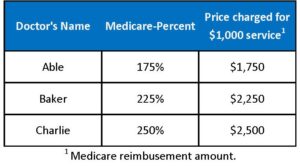
23 Jun New study reveals what you pay for hospital care and how to reduce your cost
By Greg Dattilo, CEBS
How much does your doctor and/or hospital get paid for providing you with health care services? It is nearly impossible to know until weeks after you have used a service. The price is almost always far more than you could imagine, and even if you get health insurance from an employer, that high cost affects your pocketbook.
Why does private health care cost so much? Because private health insurance must pick up providers’ losses that result from the low government payments for individuals on plans like Medicare and Medicaid. Just on these two programs, there are 144 million people enrolled, 43 percent of the U.S. population.
Every time government pays the bill for a Medicare and Medicaid patient, your private insurance and pocketbook have to fork over a little more. Why? To make up for the shortfall providers receive for Medicare and Medicaid patients.
248% More! A Hidden Tax
According to a new study out of the Rand Foundation, government payments to providers are far less than private insurance pays them for the same services. The Rand study shows that private health payments on average are 248 percent of what government pays for the same services.[i]
For example, if Medicare pays a doctor $100 for an office visit, private insurance on average will pay $248 for the same service (Rand, 2022). This is necessary so that the provider can make up for the losses that Medicare has created.
The difference between the government payments and private payments works like a Hidden Tax.
The individuals with private insurance are paying a Hidden Tax of 148 percent for medical care. This is likely the largest tax they pay on any product or service in the U.S. economy – and about this they have no knowledge and very little choice. They pay this difference in increased premium, deductibles, co-pays, and out-of-pocket expenses. Sometimes they pay by avoiding getting necessary medical care.
But how much do you pay for care?
The charge for health care services can vary by wide margins. The same service in the same town, or even the same facility, can be far more expensive in one place than another. For instance, in Minnesota, a hip replacement can cost anywhere between $6,666 and $43,359 [ii]–the same hip, but a different hospital, in the same community. In The Manual – Health Care 2020: Connecting the Dots,[iii] you will find numerous examples of these inexplicable price variations.
Why can providers get away with such variations in price? “…the payment (reimbursement) systems have created an unfriendly consumer marketplace that relies on an incomprehensible maze of billing codes resulting in unimaginable price complexity.”[iv]
The complex payment system has created the most consumer-unfriendly marketplace for medical care compared to any other product or service. It will never get better until patients (consumers) can compare prices, and that price comparison needs to be simple.
In The Manual, we explain the advantages of the Medicare-Percent. It is a single number that shows the percent of Medicare that, on average, a health care provider will accept as payment in full for services provided.
Consider Dr. Able, Baker, and Charlie. What if the law requires each of them to disclose their Medicare-Percent? The percent would be easily visible at the clinic when you check in. It would be on the provider’s website, too.
The Medicare-Percent for the three doctors is:

Comparing three doctors’ Medicare-Percents
Just knowing the Medicare-Percent gives you enough information to choose between the three doctors. Knowing the provider’s Medicare-Percent, you can easily identify who is the best value between them. Then, you could do your research to find out why.
The Minnesota legislature is already considering a bill to require all providers to disclose their Medicare-Percent. Click here to see it.
Using a Hidden Tax to force individuals with private insurance to offset the low prices paid by government must stop. Private health care prices are already out of hand. It’s time to change the health care marketplace from the most unfriendly to a friendly marketplace. This requires full price transparency in a form anyone can understand – the Medicare-Percent allows this.
Explore these ideas more at The Manual – Health Care 2020: Connecting the Dots.
[i] Whaley, C.; Briscome, R.; Kerber, R.. (2022) “Prices Paid to Hospitals by Private Health Plans – Findings from Round4 of an Employer-Led Transparency Initiative.” The Rand Foundation, Santa Monica, CA. 2022.
[ii] Nelson, Gunnar. (2018) “Health Care Cost & Utilization – Minnesota.” Minnesota Community Measurement, 2018. https://mncm.org/wp-content/uploads/2018/11/mncm-cost-report-2018.pdf.
[iii] Dattilo, G.; Racer, D. (2020) The Manual – Health Care 2020: Connecting the Dots. Alethos Press, St. Paul, MN. January 2020.
[iv] Ibid, p 24.
[v] What Medicare allows for payment.

